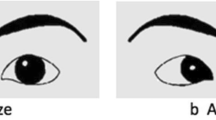Conclusions
-
1.
The averted gaze is accompanied by a turning away of the head and neck and an emotional withdrawal from reality.
-
2.
Parental influences are responsible for this symptom. It is found that the parents of such patients do not offer warm or “positive, stimulating looks” to their offspring. The parent of the same sex is usually the “weaker” and hence does not stimulate sufficient identification in the child.
-
3.
These patients suffer from paralyzing sexual conflicts, feelings of being unwanted, “moody spells,” difficulties in talking, pronounced detachment and intense hostility toward the world.
-
4.
The transference phenomena during treatment provide material to show that the major pathology revolves about the threat to the patient's self-preservation, and is pre-Oedipal.
-
5.
The fixedly averted gaze is indicative of a schizophrenic disorder, usually catatonic. In the differential diagnosis, the ephemeral and more common type of aversion of the gaze that is prompted by guilt or anxiety over Oedipal conflicts is to be distinguished.
Similar content being viewed by others
Author information
Authors and Affiliations
Rights and permissions
About this article
Cite this article
Riemer, M.D. The averted gaze. Psych Quar 23, 108–115 (1949). https://doi.org/10.1007/BF01561318
Issue Date:
DOI: https://doi.org/10.1007/BF01561318




